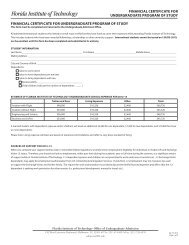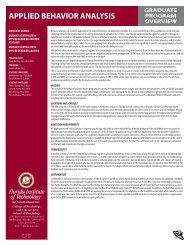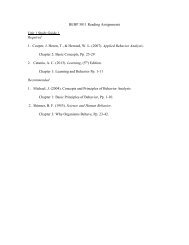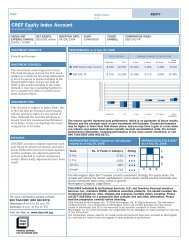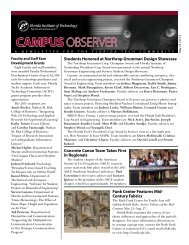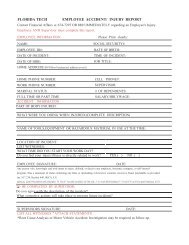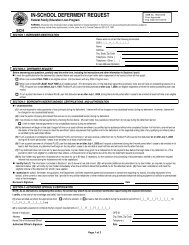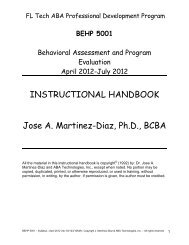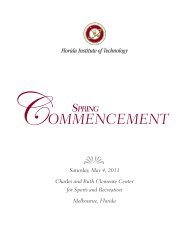2013–2014 UNIVERSITY CATALOG - Florida Institute of Technology
2013–2014 UNIVERSITY CATALOG - Florida Institute of Technology
2013–2014 UNIVERSITY CATALOG - Florida Institute of Technology
You also want an ePaper? Increase the reach of your titles
YUMPU automatically turns print PDFs into web optimized ePapers that Google loves.
SARA 0.9-m Telescope at Kitt Peak National Observatory and 0.6-m<br />
Telescope at Cerro Tololo Interamerican Observatory: <strong>Florida</strong> Tech<br />
is the administrative institution for the Southeastern Association for<br />
Research in Astronomy (SARA). See “Research” in the Institution<br />
Overview section for more information.<br />
Geospace Physics Laboratory (GPL): This facility is a collection <strong>of</strong><br />
four major laboratories that host all <strong>of</strong> <strong>Florida</strong> Tech’s space physicists,<br />
planetary scientists and their students’ research projects. These labs<br />
are outlined below (GPL–A-D). In a joint operation with UCLA <strong>of</strong><br />
California, <strong>Florida</strong> Tech is hosting a 10-site meridional array <strong>of</strong> magnetometers<br />
along the east coast <strong>of</strong> the United States (the MEASURE<br />
array) from <strong>Florida</strong> to southern Canada. The array observations, and<br />
particle and field measurements from various satellites are used for<br />
studying the geospace environment during magnetic storms and substorms.<br />
We also have joint operational custody (with the University<br />
<strong>of</strong> <strong>Florida</strong>) <strong>of</strong> the International Center for Lightning Research and<br />
Testing (ICLRT) that is located at Camp Blanding Army National<br />
Guard Base near Starke, <strong>Florida</strong>, where airspace can be controlled<br />
for rocket-triggering.<br />
Lightning and Instrument Development Laboratory (GPL-A): A<br />
series <strong>of</strong> recent theoretical breakthroughs and experimental detector<br />
development by our team working at both this lab and the ICLRT<br />
has led to the discovery <strong>of</strong> x-ray emission from lightning and its possible<br />
central role in understanding the lightning plasma processes.<br />
Exploring the implications <strong>of</strong> this discovery is one <strong>of</strong> the main goals <strong>of</strong><br />
this research lab. At the ICLRT, lightning is artificially triggered using<br />
small rockets trailing wires; in effect telling the lightning when and<br />
where to strike. This allows detailed observation and theoretical investigations<br />
to help us better understand how terrestrial (and planetary)<br />
lightning works and how to better protect lightning-vulnerable assets.<br />
Cosmic Rays and Space Weather Laboratory (GPL-B): This lab uses<br />
a network <strong>of</strong> workstations to study the energetic particle environment<br />
in the solar system. Some <strong>of</strong> the particles are cosmic rays from the<br />
galaxy, while some are produced by the sun during solar flares. By<br />
studying these particles, we try to understand the energetic phenomena<br />
in the galaxy or on the sun that affect the radiation environment at<br />
Earth. Gaining such understanding is one <strong>of</strong> our main goals to protect<br />
astronauts working in space and the electronic components on satellites.<br />
In addition, analysis <strong>of</strong> the COSPIN experiment on Ulysses and<br />
several other spacecraft datasets (Wind, SOHO, SAMPEX, ACE and<br />
RHESSI) in support <strong>of</strong> investigating the energetic particles environment<br />
with the solar system are conducted in this lab.<br />
Visualization and MHD Simulation Laboratory (GPL-C): This<br />
lab has state-<strong>of</strong>-the-art 3D visualization systems, video-processing<br />
workstations and shared memory multiprocessor systems for use in<br />
research and in the classroom. The systems use active and passive 3D<br />
displays to illustrate a variety <strong>of</strong> 3-dimensional topics. Some <strong>of</strong> the<br />
projects being pursued include classroom visuals such as 3D rendering<br />
<strong>of</strong> the Solar System, our Galaxy, and the Earth–Moon–Sun system.<br />
Scientific research in MHD modeling <strong>of</strong> space weather simulations<br />
is also conducted using 3D rendering as an analysis tool for studying<br />
the near-Earth space environment. Researchers are also investigating<br />
some cognitive science topics related to how the brain processes<br />
3D imagery and how this may affect educational techniques in the<br />
physical sciences.<br />
Space Exploration Research Laboratory (GPL-D): This lab supports<br />
a research program focused on enabling sustained human space<br />
exploration and on the origin, distribution and future <strong>of</strong> life in the universe.<br />
The lab includes imaging systems, optics, calibration and test<br />
equipment, a large clean room, and other hardware used to support<br />
the development <strong>of</strong> space instrumentation. It has a high-performance<br />
computing system for modeling and simulation, and a ground control<br />
system to receive data and send commands to the International Space<br />
Station. Some <strong>of</strong> the labs activities are housed in the new Space Life<br />
Sciences Laboratory at the Kennedy Space Center, where atomic force<br />
and laser confocal fluorescence microscopes optimized for bioimaging,<br />
small-animal research hardware, and other equipment supports<br />
research into the hazards associated with long-term human exposure<br />
to the space environment, such as radiation damage, loss <strong>of</strong> bone<br />
mass, muscle atrophy and cardiovascular de-conditioning.<br />
Teaching and Research Assistantships<br />
The department <strong>of</strong>fers a number <strong>of</strong> teaching and research assistantships<br />
each year. Teaching assistants participate in laboratory instruction<br />
and/or assisting faculty in the preparation <strong>of</strong> teaching materials and<br />
grading. Research assistants work on research projects that are <strong>of</strong>ten<br />
related to their own master’s thesis or doctoral dissertation investigations.<br />
Both types <strong>of</strong> assistantships are awarded on a competitive basis,<br />
and provide graduate course fee remission and a stipend for living<br />
expenses. To increase the probability <strong>of</strong> receiving an assistantship,<br />
applicants are advised to apply as early as possible in the academic<br />
year prior to requested admission.<br />
<strong>2013–2014</strong> Degree Programs—College <strong>of</strong> Science 223




